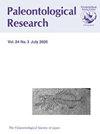日本长崎Iki的一种新的中新世杯状鱼类,Odontobutis hayashitokuei
IF 0.6
4区 地球科学
Q3 PALEONTOLOGY
引用次数: 0
摘要
摘要在日本长崎Iki岛中中新世Chojabaru组淡水沉积物中发现了一种新的虾形鱼Odontobutis hayashitokuei sp. nov.。这个新种不同于齿蟾属的其他种,它有21个尾椎骨和一个较小的头。齿蟾(Odontobutis hayashitokuei sp. 11 .)与齿蟾(O. obscura)最相似的是其背鳍和肛鳍的位置几乎相同。这是齿齿龙属的第一个化石物种,表明齿齿龙属的起源可以追溯到中新世中期,大约15 Ma。本文章由计算机程序翻译,如有差异,请以英文原文为准。
A New Miocene Gobiiform Fish, Odontobutis hayashitokuei from Iki, Nagasaki, Japan
Abstract. A new gobiiform fish Odontobutis hayashitokuei sp. nov. is decribed from middle Miocene freshwater deposits of the Chojabaru Formation in Iki Island, Nagasaki, Japan based on a single specimen. This new species differs from other species of the genus Odontobutis in having 21 caudal vertebrae and a smaller head. Odontobutis hayashitokuei sp. nov. is most similar to O. obscura in having almost the same position of dorsal and anal fins. This is the first fossil species of the genus Odontobutis and suggests that the origin of the genus extends to the middle Miocene, about 15 Ma.
求助全文
通过发布文献求助,成功后即可免费获取论文全文。
去求助
来源期刊

Paleontological Research
PALEONTOLOGY-
CiteScore
1.60
自引率
0.00%
发文量
47
审稿时长
>12 weeks
期刊介绍:
Paleonotological Research (PR) is a quarterly, peer-reviewed international journal, which focuses on original contributions primarily in the area of paleontology but also covering a wide range of allied sciences. It has been published since 1997 as a successor to the former journal Transactions and Proceedings of the Palaeontological Society of Japan. The emphasis of contributions will include global and local perspectives, and contents can cover all ages (Precambrian to the Quaternary, including the present time).
 求助内容:
求助内容: 应助结果提醒方式:
应助结果提醒方式:


